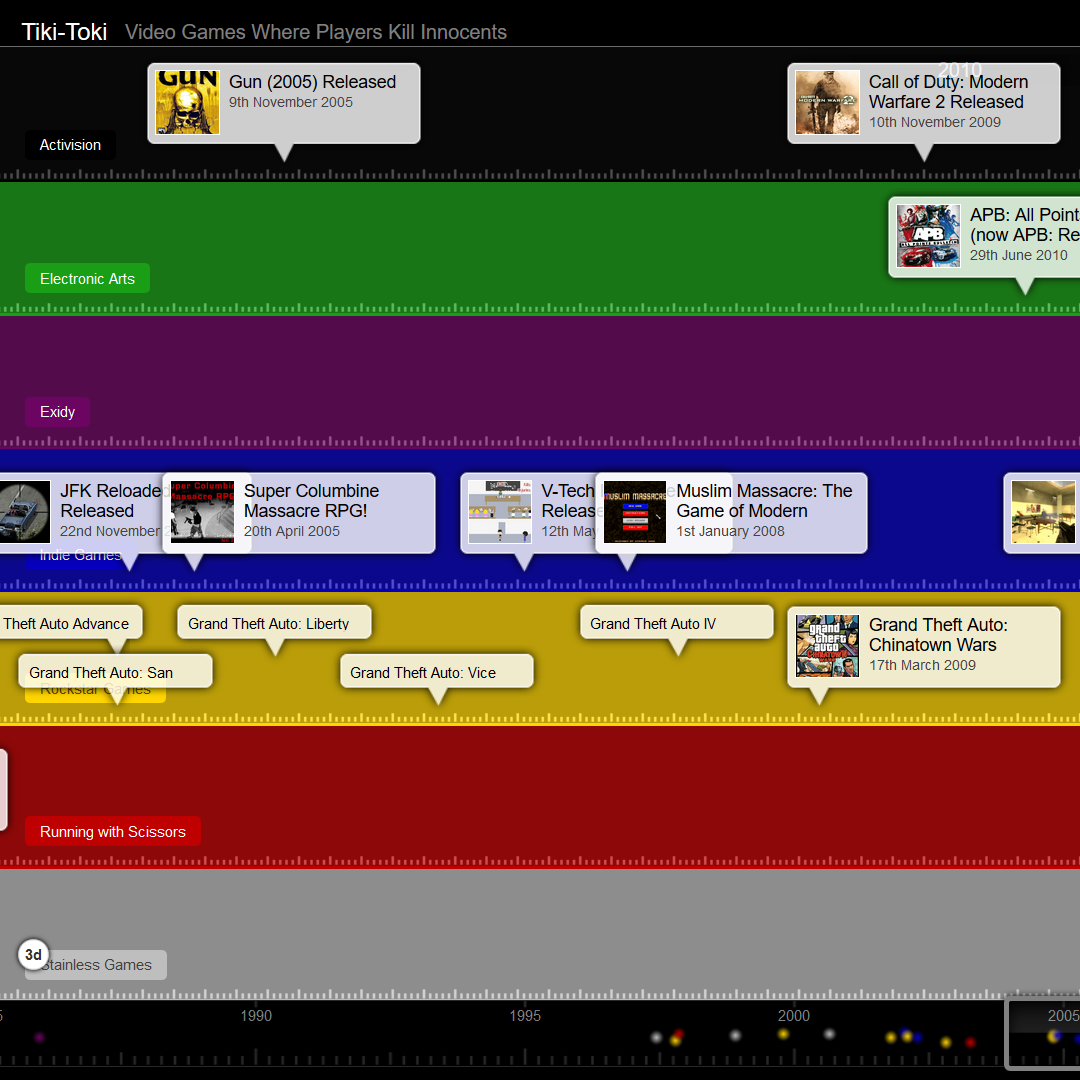Video Games Where Players Kill Innocents: A Timeline Analysis
Written Monday, March 04, 2019
Posted Saturday, January 18, 2020 in Games
This timeline is meant to document notable and obscure video games that give the player the ability to kill innocents and analyze why and how the feature is implemented throughout the years. It was made for a project in my Social Impacts of Video Games course.

Click here to be taken to the timeline on Tiki-toki.com.
The ability to kill innocents in video games is closely tied to the media's reaction to it. In the early days of video games, Death Race (1976) seems to be the first case of the media losing it over a game of this kind. The first game in this category released in 1997, Carmageddon, seems to be influenced by Death Race. That same year both the famous Grand Theft Auto series and the Postal series began - with controversy, as expected. Whereas GTA focused on violent lawlessness for money, Postal was named after the phenomenon of "going postal" (meaning workplace violence) which had become a thing as early back as 1986. Coincidentally, the controversial arcade game about torture, Chiller, came out 1986. The 2000s saw a lot of GTA games, as well as the sequel to Postal. Indie games started growing in number as technology became cheaper and more easily available to the public. In the years following the September 11, 2001 attacks, indie games emerged that were hateful towards Muslims and terrorism, and industry games received backlash if they had anti-government themes. At the same time, some games tried dealing with the nation’s trauma with humor. The black comedy Postal 2 pokes fun at the media, politics, and American stereotypes and includes Islamist terrorists as one of several enemy groups in the game.
In 2005, we see possibly the first example of a game based on a school shooting in which the player takes the role of the perpetrator. Super Columbine Massacre RPG! was based on the 1999 Columbine High School shooting that shook the world, and this game called to question what is okay to depict in video games in the name of art. The infamous JFK Reloaded, in which you play the shooter who takes John F. Kennedy’s life, was released only a year prior and similarly brought up this ethical question. From 2006 to 2008, as the GTA series was reaching new heights in realism and violence, indie game developers continued developing offensive games to get attention. In GTA IV, however, flyable planes were missing from the game, and many speculated that this was because the game map resembled NYC too closely. This shows that despite violent games being popular, there was still a need for sensitivity in big-name games following the 9/11 attacks. Ironically, in 2009 there was a massive controversy involving the “No Russian” level in Call of Duty: Modern Warfare 2. In this level, the player assumes the role of an undercover CIA agent who must participate in a mass shooting in a Moscow airport to gain the trust of the villain. However, his plan is to blame the Americans for the shooting to start a war, so the shooters speak “no Russian” and frame the CIA agent by killing him and leaving his body at the scene since, unbeknownst to the player character, the shooters had already discovered the spy. The player doesn’t have to shoot civilians, and the level was made optional due to the backlash and removed entirely from the Russian version of the game.
Into the 2010s, indie games centered around being the perpetrator in violent acts towards innocents increase in volume around notable mass shootings reported in the media. By this point, reporting on mass shootings had hit such a point where the most recent GTA game greatly reduced the number of locations where the player can attack civilians. In the previous two main titles in the series the player could walk into and attack strip clubs, theatres, casinos, restaurants, and more, but these locations resembled the locations of many awful real-life shootings that occurred later in the decade and were scrapped from the 2013 title. AAA games cannot afford to be offensive to the public or publishers lose money. Indie games, on the other hand, happily ride the tail of controversy to get noticed and make sales from the media frenzy. However, because it’s such a sensitive topic, this strategy sometimes backfires on the developer and costs them everything. For this reason, many indie developers of these types of games try to remain anonymous.
In conclusion, from my research to create this timeline of video games where players kill innocents I have determined that throughout the years AAA developers have tried to avoid the topic of mass murder in video games while indie developers have done the complete opposite. Whether it’s for creative expression or to shamelessly profit off of the controversy, indie developers won’t be stopping.
Resources
- All resources in timeline.
- Software used: Tiki-toki.com